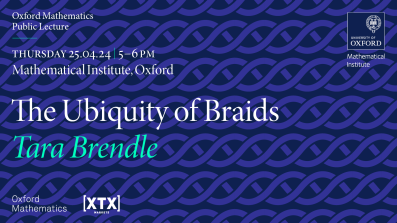methods for nonlinear nonlocal Fokker-Planck equations
methods for nonlinear nonlocal Fokker-Planck equations
from coma after cardiac arrest
17:00
The Ubiquity of Braids - Tara Brendle
What do maypole dancing, grocery delivery, and the quadratic formula all have in common? The answer is: braids! In this talk Tara will explore how the ancient art of weaving strands together manifests itself in a variety of modern settings, both within mathematics and in our wider culture.
Tara Brendle is a Professor of Mathematics in the School of Mathematics & Statistics at the University of Glasgow. Her research lies in the area of geometric group theory, at the interface between algebra and topology. She is co-author of 'Braids: A Survey', appearing in 'The Handbook of Knot Theory'.
Please email @email to register to attend in person.
The lecture will be broadcast on the Oxford Mathematics YouTube Channel on Thursday 16 May at 5-6pm and any time after (no need to register for the online version).
The Oxford Mathematics Public Lectures are generously supported by XTX Markets.

How do you like your boards? Black with chalk or white with pen?
We took a Swiftie boardwalk round Oxford Mathematics.
38 seconds of chalk and marker pen - and a few mathematicians - in the video below.
There are plenty more clips of mathematical life on our YouTube Channel including tips from Philip Maini on clever laziness, Roger Penrose's Impossible Triangle and some pasta probability puzzles.


